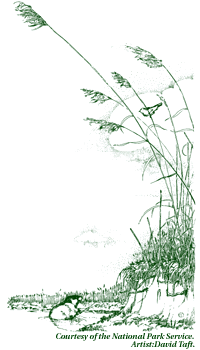 Chapter 1 Chapter 1
The Delaware Bayshore:
Locally Cherished, Globally Significant
The Delaware Bayshore1 stretches along the southwestern coast of New Jersey. Comprising tidal rivers, salt marshes, woodlands, farms and historic towns and cities, the Bayshore is rich in natural and cultural resources. Though it encompasses dozens of municipalities and four counties, the Bayshore functions as one interdependent system –– an ecosystem –– of water, soil, plants, animals and people.
The Delaware Bayshore is known world wide for its vast wetlands and associated wildlife. As a major stop on the Atlantic flyway, the easternmost bird migration route in the Americas, the Bayshore offers resting and feeding grounds for more than a million migrating birds each spring. In fact, the shorebird population that assembles on Delaware Bay for a few weeks each May and June is the second largest in the Western Hemisphere.2 In addition to these avian migrants, many rare and endangered species, including sensitive joint vetch, sturgeon and scarlet snake, depend on the region’s waters, wetlands and uplands. Humans also rely on these resources, supporting a way of life historically based on the outdoors. Generations have earned a livelihood fishing, farming, boating, oystering, crabbing, hunting and trapping in and along Delaware Bay tributaries.
Life at the Bayshore is a complex quilt. It is woven from interactions among physical factors like hydrology, soils, climate and geology; the needs and contributions of thousands of species of plants and animals; and the ubiquitous impact of human activity such as roads, housing, mines and farms. Broadly speaking, the ecology of the region is not only the interdependence among many natural elements but also their relationship with human culture.
Soils and hydrology, for example, not only determine patterns of vegetation and the productivity of land but also the suitability of various sites for development. These factors in turn influence where people live and how they use the land.
ecosystem
The place, usually spanning multiple and adjacent habitats, where specific sets of interactions and functions between organisms and the physical environment and among species are expected to occur. In degraded ecosystems, important functions and interactions are diminished.
Atlantic flyway
The easternmost bird migration corridor in the Americas, followed by songbirds, raptors, waterfowl and shorebirds.
hydrology
The science of water, concerned with the origin, circulation, distribution and properties of water above and below the ground.
ecology
The scientific study of interactions among individual species or communities or between biological and physical factors like hydrology, climate, soils, geology, fire, or land-use history.
An addendum to include: Appendix A from Charting a Course (pages 136–138) –– Ongoing Projects in the Delaware Bayshore Region |
1. In this plan, the term ‘Delaware Bayshore,’ or ‘Bayshore,’ is synonymous with the project area and New Jersey’s Delaware Bay Watershed. This is a broader definition than most planners and local residents commonly use. More often, the term Delaware Bayshore refers only to those communities that abut the Bay.
2. After the Cooper River Delta in Alaska.
Excerpts from Charting a Course for the Delaware Bay Watershed* by Harriet B. Honigfeld, New Jersey Conservation Foundation, Bamboo Brook, 170 Longview Road, Far Hills, New Jersey07931-2623, (908) 234-1225, Copyright 1997
*A wonderful resource and a “must have” reference for teachers in the Down Jersey region. |

